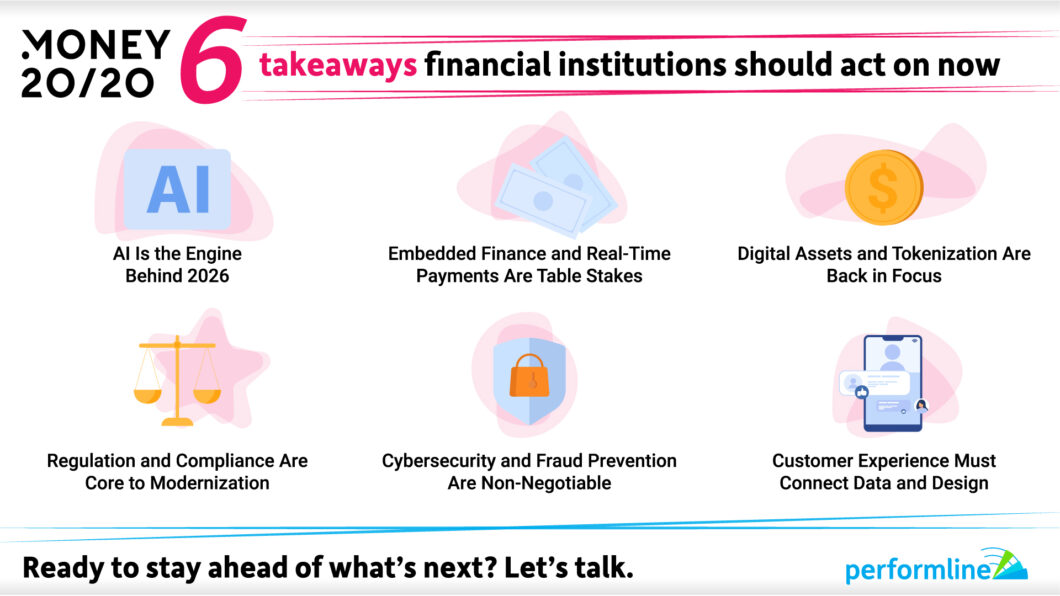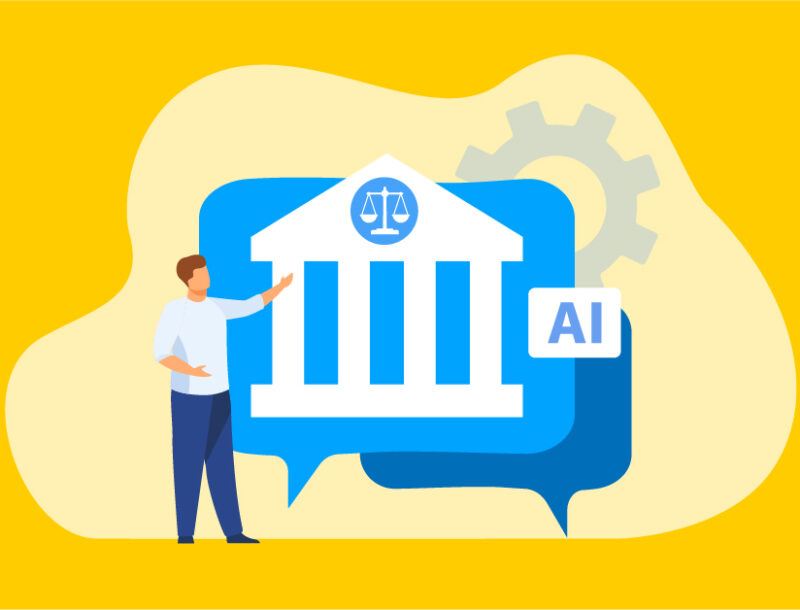Money20/20 2025: 6 Moves Financial Institutions Should Make Now

Money20/20 continues to serve as a benchmark for what’s next in financial services, and this year was no different. From AI-driven innovation to regulatory readiness, the 2025 event made one thing clear: modernization isn’t on the horizon—it’s here.

Here are six takeaways financial institutions should act on now to stay ahead.
1. AI Is the Engine Behind 2026
Generative AI and machine learning took center stage in sessions covering customer experience, underwriting, fraud detection, and operational efficiency.
Why it matters:
AI isn’t just another tech trend; it’s the foundation for modernizing legacy systems. With the right governance, banks can use AI to make faster decisions, automate repetitive work, and deliver better service at scale.
What to do next:
- Build an AI governance and risk framework that includes explainability, data lineage, and fairness checks.
- Pilot GenAI responsibly by starting small with chatbots or credit support tools using sanitized data.
- Strengthen data infrastructure since even the smartest models depend on clean, reliable data.
2. Embedded Finance and Real-Time Payments Are Table Stakes
Conversations around real-time rails, payments orchestration, and embedded finance partnerships were everywhere. The expectation for instant, integrated payment experiences is now standard.
Why it matters:
Without modern APIs and real-time infrastructure, traditional institutions risk losing ground to agile fintechs and non-bank competitors.
Action items:
- Assess your payments stack against FedNow and RTP capabilities.
- Create an embedded finance API roadmap that outlines offerings, partner requirements, and revenue models.
- Use modular solutions to launch faster and reduce implementation time.
3. Digital Assets and Tokenization Are Back in Focus
While crypto hype has cooled, digital asset infrastructure is maturing. Tokenization, custody, and programmable money are gaining traction, especially for institutional use cases.
Why it matters:
Tokenized assets are reshaping capital markets, but they also introduce new compliance obligations.
To prepare:
- Start with pilot custody programs, then scale to tokenized offerings.
- Partner early with custody providers and legal teams on controls like proof-of-reserves and auditability.
- Design AML and KYC workflows for token transactions before expanding services.
4. Regulation and Compliance Are Core to Modernization
Compliance was not an afterthought; it was a mainstage topic. From AI ethics to open banking and crypto policy, regulators are setting the pace for innovation.
Why it matters:
If compliance isn’t embedded from day one, modernization efforts will stall. Regulatory frameworks determine not just what’s possible, but how quickly innovation can scale.
How to turn compliance into an advantage:
- Integrate compliance checkpoints into every modernization project, from consent tracking to audit logging.
- Conduct cross-functional regulatory impact assessments for products involving AI, crypto, or embedded finance.
- Use compliance automation tools, like PerformLine, to monitor, audit, and report across all marketing and customer channels.
5. Cybersecurity and Fraud Prevention Are Non-Negotiable
As payment systems open and transactions accelerate, fraud risks increase. Sessions spotlighted AI-based authentication, behavior-based risk detection, and API security as must-haves.
Why it matters:
Faster systems without real-time fraud controls introduce more risk than reward. Security has to evolve in tandem with modernization.
Steps to take:
- Adopt risk-based authentication that adjusts in real time.
- Strengthen your infrastructure through red-team testing, cloud security, and SRE practices.
- Test early and continuously when launching new digital or payment products.
6. Customer Experience Must Connect Data and Design
Customer experience tied every conversation about growth. Data-driven personalization, seamless onboarding, and responsive design are what set leading institutions apart.
Why it matters:
Even the most advanced technology will fail if the user experience creates friction. Open banking, portability, and intuitive design are becoming key differentiators.
CX modernization checklist:
- Map end-to-end customer journeys and identify friction points.
- Implement customer data platforms (CDPs) that support personalization while maintaining compliance.
- Use API-first tools and feature flags to iterate quickly and improve continuously.
The Takeaway: Compliance Should Be Built In, Not Bolted On
Every major trend at Money20/20 pointed to one truth: innovation moves fast, but compliance defines how far it can go. Whether you’re testing AI, modernizing payments, or piloting digital assets, compliance must be part of your foundation.
At PerformLine, we help organizations make compliance automatic with always-on monitoring, discovery, and reporting that enable transparency, scalability, and peace of mind.
Ready to stay ahead of what’s next? Let’s talk.
FAQs
Modernization is now, not next. The fastest movers are building AI governance, enabling real-time payments, and banking compliance into every project from day one.
Create an AI governance framework that covers data lineage, model explainability, access controls, and fairness checks. Start with small pilots, such as support chat or underwriting assistance, in a sandbox with sanitized data.
Both enable real-time payments in the United States. RTP is a private network, FedNow is operated by the Federal Reserve. Many institutions pursue both to maximize reach and uptime while using orchestration to route transactions. From a marketing compliance standpoint, ensure all related messaging accurately represents transaction timing, settlement finality, and customer protections under applicable disclosure requirements.
Use an API-first approach and a partner checklist that covers authentication, settlement, data sharing, and revenue models. Start with targeted use cases such as co-branded wallets or point-of-sale lending.
Yes. Tokenization and custody are gaining traction for institutional use cases. Begin with custody pilots, define AML and KYC workflows, and coordinate with legal on controls like proof of reserves and auditability.
Compliance becomes a catalyst—not a bottleneck—when it’s built into delivery workflows from the start. By mapping compliance checkpoints across every stage of development, such as consent tracking, audit logging, and regulatory impact assessments, teams can proactively address risks instead of reacting to issues later. Automation is key: tools like PerformLine enable continuous monitoring, review, and reporting across marketing and customer communication channels. This reduces manual effort, increases transparency, and gives teams the confidence to move faster with fewer regulatory surprises.
Adopt risk-based authentication, harden APIs, and run red team tests. Add fraud models that update in near real time and include continuous testing in each release.
Track time to market, adoption and activation, fraud loss rate, SLA and latency, conversion through onboarding, and compliance findings closed on time. For AI, add model quality, safety exceptions, and human override rates.



